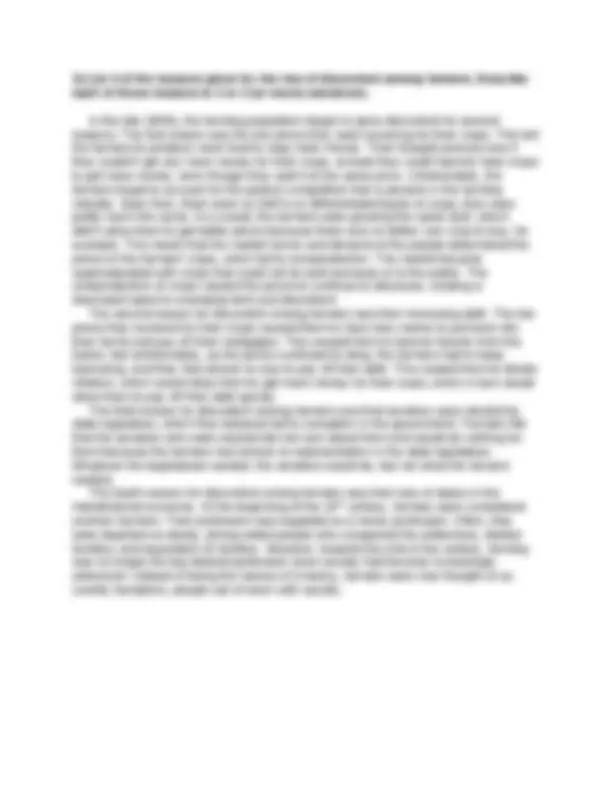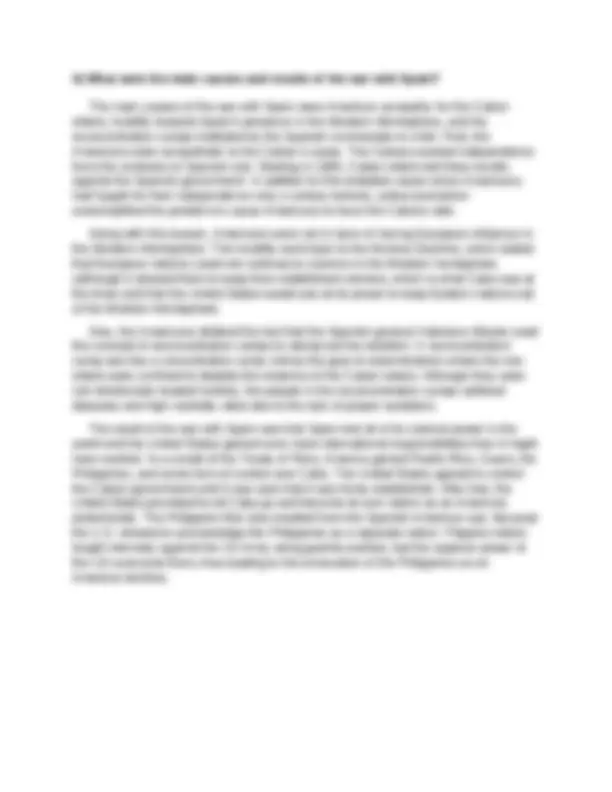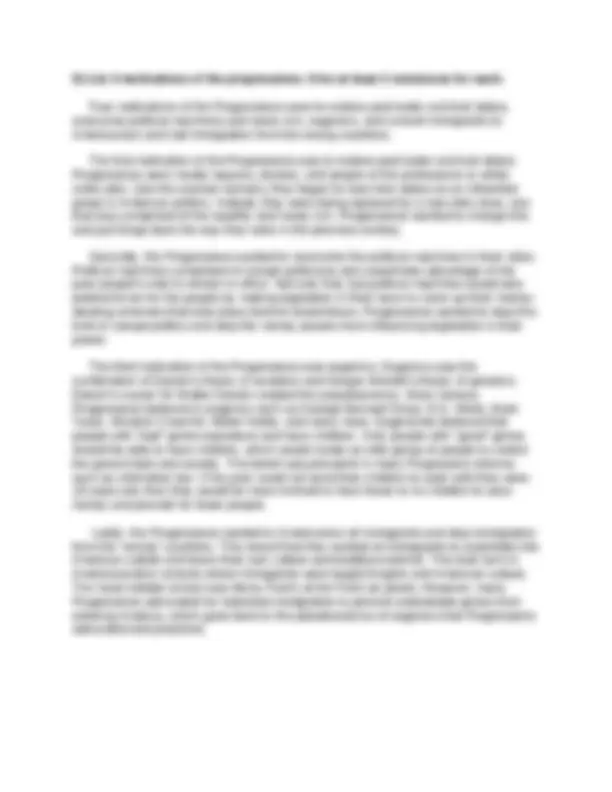





Study with the several resources on Docsity

Earn points by helping other students or get them with a premium plan


Prepare for your exams
Study with the several resources on Docsity

Earn points to download
Earn points by helping other students or get them with a premium plan
Community
Ask the community for help and clear up your study doubts
Discover the best universities in your country according to Docsity users
Free resources
Download our free guides on studying techniques, anxiety management strategies, and thesis advice from Docsity tutors
This document examines the methods used by southern states in the late 1800s to disenfranchise african american voters, including the poll tax, literacy tests, and white primaries. It provides detailed descriptions of how these techniques effectively prevented many black citizens from exercising their right to vote, while disproportionately impacting the poor and uneducated. The document also explores the broader context of the post-civil war era, including the rise of political machines, the growth of the civil service, and the increasing discontent among farmers. Additionally, it delves into the motivations and characteristics of the progressive movement, as well as the split within the women's rights movement over the issue of protective legislation. This comprehensive analysis offers valuable insights into a pivotal period in american history and the ongoing struggle for voting rights and social justice.
Typology: Essays (high school)
1 / 7

This page cannot be seen from the preview
Don't miss anything!




1) 3 methods southern states used to disenfranchise black voters were: Poll tax Literacy test White primary Describe what each of these did and how they were able to disenfranchise black voters. In the late 1800s, the southern states used several techniques to disenfranchise African American voters. Most of these techniques started after 1876, when President Hayes ended Reconstruction and white legislators came back to power. One of these ways was to create a poll tax. This poll tax applied to every voter but was aimed at African Americans. Many were sharecroppers or domestic workers, and they didn't make much money. As a result, many African Americans were unable to afford the poll tax. However, this poll tax did not solely affect African Americans, as there were poor whites as well who were unable to pay the poll tax. However, the percentage of poor whites was significantly lower compared to the percentage of poor blacks, thus disenfranchising more blacks than whites. A second way that southern states used to disenfranchise black voters was the creation of literacy tests. Most black voters were illiterate and thus could not pass the literacy test. However, this test also affected any illiterate whites who attempted to vote. To solve this problem, southern legislators created the grandfather clause. This stated that if your grandfather voted before the Civil War, then you could vote too. This also was aimed at black voters, because most of their grandfathers were slaves, not to mention some of them were emancipated by the Emancipation Proclamation of 1860. Slaves were denied the right to vote, so the grandfather clause to the literacy test made sure that illiterate whites could vote, but illiterate African Americans could not. Lastly, the Southern legislators used the white primary technique. The Democratic party was the party of the South and they were against black voters. However, the 15th Amendment stated that you could not prevent anyone from voting based on race, ethnicity, or color. Unfortunately, the amendment said nothing about voting in the primaries. The Democratic Party took advantage of this and prohibited any blacks from voting in their primaries. This was to ensure that the Democratic candidate in the general election would be white. If they were white, they would cater to the white southern view of legislation and ignore the voice of the black population.
2) Describe the spoils system, why it sort of worked in the early years, and why it became obsolete after the Civil War. That means, how did government employment evolve so that the spoils system no longer was useful. What act of Congress took the government off the spoils system? In the middle third of the 19th century, the government employment system was based on what was called the spoils system. This system guaranteed that party favorites would get the jobs they wanted if the candidate was elected. For example, if a Republican won the presidency, he would make sure that all of his friends would be appointed to the civil servant jobs like postmasters. This system was based on the distrust of professional politicians and bureaucrats. It allowed several things including:
4) What were the main causes and results of the war with Spain? The main causes of the war with Spain were American sympathy for the Cuban rebels, hostility towards Spain’s presence in the Western Hemisphere, and the reconcentration camps instituted by the Spanish commander-in-chief. First, the Americans were sympathetic to the Cuban’s cause. The Cubans wanted independence from the centuries of Spanish rule. Starting in 1865, Cuban rebels led three revolts against the Spanish government. In addition to this relatable cause (since Americans had fought for their independence only a century before), yellow journalism oversimplified the problem to cause Americans to favor the Cubans side. Along with this reason, Americans were not in favor of having European influence in the Western Hemisphere. This hostility went back to the Monroe Doctrine, which stated that European nations could not continue to colonize in the Western hemisphere (although it allowed them to keep their established colonies, which is what Cuba was at the time) and that the United States would use all its power to keep Eastern nations out of the Western Hemisphere. Also, the Americans disliked the fact that the Spanish general Valeriano Weyler used the concept of reconcentration camps to stamp out the rebellion. A reconcentration camp was like a concentration camp (minus the goal of extermination) where the non- rebels were confined to deplete the reserves of the Cuban rebels. Although they were not intentionally treated horribly, the people in the reconcentration camps suffered diseases and high mortality rates due to the lack of proper sanitation. The result of the war with Spain was that Spain lost all of its colonial power in the world and the United States gained even more international responsibilities than it might have wanted. As a result of the Treaty of Paris, America gained Puerto Rico, Guam, the Philippines, and some form of control over Cuba. The United States agreed to control the Cuban government until it was sure that it was firmly established. After that, the United States promised to let Cuba go and become its own nation as an American protectorate. The Philippine War also resulted from the Spanish-American war, because the U.S. refused to acknowledge the Philippines as a separate nation. Filippino rebels fought intensely against the US Army using guerilla warfare, but the superior power of the US overcame them, thus leading to the annexation of the Philippines as an American territory.
5) List 4 motivations of the progressives. Give at least 2 sentences for each. Four motivations of the Progressives were to restore past luster and lost status, overcome political machines and newly rich, eugenics, and convert immigrants to Americanism and halt immigration from the wrong countries. The first motivation of the Progressives was to restore past luster and lost status. Progressives were mostly lawyers, doctors, and people of the professions or white- collar jobs. Like the yeoman farmers, they began to lose their status as an influential group in American politics. Instead, they were being replaced by a new elite class, one that was comprised of the wealthy and newly rich. Progressives wanted to change this and put things back the way they were in the previous century. Secondly, the Progressives wanted to overcome the political machines in their cities. Political machines comprised of corrupt politicians who would take advantage of the poor people’s vote to remain in office. Not only that, but political machines would also pretend to be for the people by making legislation in their favor to cover up their money- stealing schemes that took place behind closed doors. Progressives wanted to stop this kind of corrupt politics and stop the money powers from influencing legislation in their power. The third motivation of the Progressives was eugenics. Eugenics was the combination of Darwin’s theory of evolution and Gregor Mendel’s theory of genetics. Darwin’s cousin Sir Walter Darwin created the pseudoscience. Many famous Progressives believed in eugenics such as George Bernard Shaw, H.G. Wells, Mark Twain, Winston Churchill, Hellen Keller, and many more. Eugenicists believed that people with “bad” genes reproduce and have children. Only people with “good” genes should be able to have children, which would create an elite group of people to control the government and society. This belief was prevalent in many Progressive reforms such as child labor law. If the poor could not send their children to work until they were 18 years old, then they would be more inclined to have fewer to no children to save money and provide for fewer people. Lastly, the Progressives wanted to Americanize all immigrants and stop immigration from the “wrong” countries. This meant that they wanted all immigrants to assimilate into American culture and leave their own culture and traditions behind. This took form in Americanization schools where immigrants were taught English and American culture. The most notable school was Henry Ford’s at the Ford car plants. However, many Progressives advocated for restricted immigration to prevent undesirable genes from entering America, which goes back to the pseudoscience of eugenics that Progressives advocated and practiced.
7) Describe the split in the women's movement between those who wanted to protect women and those who wanted to improve women's political rights. In the Progressive Era, women’s rights was a major issue. However, the debate was split between those who wanted women’s rights and those who didn’t. Those who did want equal pay for women, women’s suffrage, and the ability to work just as much as men. They believed that women were more sensitive to moral issues, and they used this argument to try to gain women’s suffrage. The theory was, that if women, being more sensitive to moral issues than men, were able to vote, the country would be a more morally sound place. Drinking, prostitution, war, etc. would be almost eradicated just by the female vote. In addition, proponents of women’s rights opposed protective legislation that would limit women to certain working hours and conditions. Although women were proven to be more fragile than men, advocates of women’s rights believed that it was morally wrong to prevent women from being able to do the same work as men. Lastly, advocates for women’s rights wanted equal pay for women across the board. This was because in some cases, women made more money than men doing the same job, but the majority of the time they made a fraction of what men were paid to do the same job. This, they believed, was unfair to the woman, and so they demanded equal pay and equal rights for women. On the other hand, opponents of women’s rights argued protective legislation was a good thing. At the time, about 40% of all working women were young single women. These people wanted to protect the young women from rape and overwork. They believed that if protective legislation was not enforced, employers would take advantage of women and they wanted to prevent that from happening. In addition, they argued that protective legislation would protect pregnant women from overwork and strenuous labor that could affect the unborn child. They also feared that without protective legislation, pregnant women wouldn’t be able to get maternity leave to care for their newborns. As for the right to vote, most men , but some women believed that women were not competent enough to understand politics and the intricacies of the government, which would prevent them from making the wise choice in elections. It is important to note that most women who advocated protective legislation agreed with those who opposed it on other matters such as the right to vote and equal pay. The main split was over protective legislation.